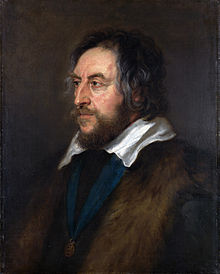- Arundel marbles
-
The Arundelian Marbles are a collection of Greek marbles collected by Thomas Howard, 21st Earl of Arundel in the early seventeenth century, the first such comprehensive collection of its kind in England. They now belong to the Ashmolean Museum, Oxford University, as a result of a gift made by his grandson Henry Howard, 6th Duke of Norfolk in 1667[1] and of a supplementary gift in 1755, when the extravagant 2nd Earl of Pomfret sold back to his mother those Arundel marbles that had been at Easton Neston, and she donated them to the Ashmolean, where sometimes they are called the Pomfret marbles.
The Earl of Arundel had supervised excavations in Rome , and deployed his agents in the Eastern Mediterranean, above all at Istanbul. Late in the seventeenth century, an English visitor to Ottoman Turkey could complain that "the scarcity of antiquities now to be found in Smyrna arises from hence, that it furnished the greatest part of the Marmora Arundeliana." The earl displayed his unrivalled collections at Arundel House, London.
Some of these marbles are not works of art but important inscriptions, the first Greek inscriptions that had been seen in England, from which historians have confirmed many dates in Greek history. Among them is the Parian Chronicle, inscribed about 263 BC so called because it was found on Paros, which gives Greek dates from 1582 BC down to 354 BCE [2] Among outstanding pieces is a metrological relief that shows parts of the human body, outstretched arms, elbow to finger tips, foot, clenched fists and fingers and was used as a standard unit of measure.
The Arundel marbles had been catalogued as early as 1628, when, at the suggestion of Sir Robert Bruce Cotton, John Selden had compiled a catalogue, Marmora Arundeliana, with the assistance of two others, Patrick Young and Richard James. In 1763 Richard Chandler published a fine edition of the inscriptions as Arundelian Marbles, Marmora Oxoniensia with a Latin translation, and a number of suggestions for supplying the lacunae.
References
- ^ John Evelyn and John Selden were instrumental in motivating this gift.
- ^ A smaller fragment of the relief, covering 356–299 BCE is conserved in the museum on Paros.
- Denys Eyre Lankester Haynes, 1975. The Arundel marbles (Oxford : University of Oxford, Ashmolean Museum)
- Michael Vickers, Arundel and Pomfret Marbles in Oxford (Ashmolean Museum) ISBN 1-85444-207-4
- Benjamin Anderson, curator, The Invention of Antiquity, exhibition at Bryn Mawr, 2004: "Epigraphy and Wanderlust"]
- Chambers' Book of Days: A Miscellany of Popular Antiquities, 1869 "July 7th"
Categories:- Collection of the Ashmolean
- Collections of classical sculpture
- Former private collections
Wikimedia Foundation. 2010.

